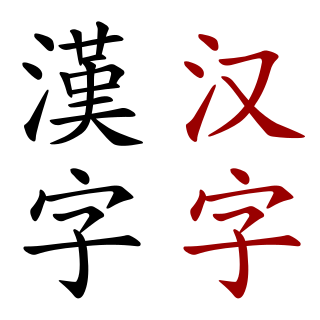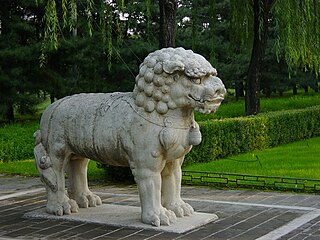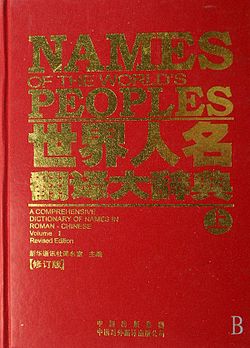
Chinese is a group of languages spoken natively by the ethnic Han Chinese majority and many minority ethnic groups in China. Approximately 1.35 billion people, or around 16% of the global population, speak a variety of Chinese as their first language.
Hanyu Pinyin, or simply pinyin, is the most common romanization system for Standard Chinese. In official documents, it is referred to as the Chinese Phonetic Alphabet. It is the official system used in China, Singapore, Taiwan, and by the United Nations. Its use has become common when transliterating Standard Chinese mostly regardless of region, though it is less ubiquitous in Taiwan. It is used to teach Standard Chinese, normally written with Chinese characters, to students already familiar with the Latin alphabet. The system makes use of diacritics to indicate the four tones found in Standard Chinese, though these are often omitted in various contexts, such as when spelling Chinese names in non-Chinese texts, or when writing non-Chinese words in Chinese-language texts. Pinyin is also used by various input methods on computers and to categorize entries in some Chinese dictionaries. Hànyǔ literally means 'Han language'—meaning, the Chinese language—while pinyin literally means 'spelled sounds'.

In a written language, a logogram, also logograph or lexigraph, is a written character that represents a semantic component of a language, such as a word or morpheme. Chinese characters as used in Chinese as well as other languages are logograms, as are Egyptian hieroglyphs and characters in cuneiform script. A writing system that primarily uses logograms is called a logography. Non-logographic writing systems, such as alphabets and syllabaries, are phonemic: their individual symbols represent sounds directly and lack any inherent meaning. However, all known logographies have some phonetic component, generally based on the rebus principle, and the addition of a phonetic component to pure ideographs is considered to be a key innovation in enabling the writing system to adequately encode human language.

Chinese characters are logographs used to write the Chinese languages and others from regions historically influenced by Chinese culture. Chinese characters have a documented history spanning over three millennia, representing one of the four independent inventions of writing accepted by scholars; of these, they comprise the only writing system continuously used since its invention. Over time, the function, style, and means of writing characters have evolved greatly. Informed by a long tradition of lexicography, modern states using Chinese characters have standardised their forms and pronunciations: broadly, simplified characters are used to write Chinese in mainland China, Singapore, and Malaysia, while traditional characters are used in Taiwan, Hong Kong, and Macau.

Chinese names are personal names used by individuals from Greater China and other parts of the Sinophone world. Sometimes the same set of Chinese characters could be chosen as a Chinese name, a Hong Kong name, a Japanese name, a Korean name, a Malaysian Chinese name, or a Vietnamese name, but they would be spelled differently due to their varying historical pronunciation of Chinese characters.

In linguistics, romanization or romanisation is the conversion of text from a different writing system to the Roman (Latin) script, or a system for doing so. Methods of romanization include transliteration, for representing written text, and transcription, for representing the spoken word, and combinations of both. Transcription methods can be subdivided into phonemic transcription, which records the phonemes or units of semantic meaning in speech, and more strict phonetic transcription, which records speech sounds with precision.
The names for chemical elements in East Asian languages, along with those for some chemical compounds, are among the newest words to enter the local vocabularies. Except for those metals well-known since antiquity, the names of most elements were created after modern chemistry was introduced to East Asia in the 18th and 19th centuries, with more translations being coined for those elements discovered later.

"Lion-Eating Poet in the Stone Den" is a short narrative poem written in Classical Chinese that is composed of about 94 characters in which every word is pronounced shi when read in present-day Standard Mandarin, with only the tones differing.
Phono-semantic matching (PSM) is the incorporation of a word into one language from another, often creating a neologism, where the word's non-native quality is hidden by replacing it with phonetically and semantically similar words or roots from the adopting language. Thus the approximate sound and meaning of the original expression in the source language are preserved, though the new expression in the target language may sound native.

An endonym is a common, native name for a group of people, individual person, geographical place, language or dialect, meaning that it is used inside a particular group or linguistic community to identify or designate themselves, their homeland, or their language.

In modern Japanese, ateji principally refers to kanji used to phonetically represent native or borrowed words with less regard to the underlying meaning of the characters. This is similar to man'yōgana in Old Japanese. Conversely, ateji also refers to kanji used semantically without regard to the readings.

Transcription into Chinese characters is the use of traditional or simplified Chinese characters to phonetically transcribe the sound of terms and names of foreign words to the Chinese language. Transcription is distinct from translation into Chinese whereby the meaning of a foreign word is communicated in Chinese. Since English classes are now standard in most secondary schools, it is increasingly common to see foreign names and terms left in their original form in Chinese texts. However, for mass media and marketing within China and for non-European languages, particularly those of the Chinese minorities, transcription into characters remains very common.
An English exonym is a name in the English language for a place, or occasionally other terms, which does not follow the local usage. Exonyms and endonyms are features of all languages, and other languages may have their own exonym for English endonyms, for example Llundain is the Welsh exonym for the English endonym "London".

The debate on traditional Chinese characters and simplified Chinese characters is an ongoing dispute concerning Chinese orthography among users of Chinese characters. It has stirred up heated responses from supporters of both sides in mainland China, Hong Kong, Macau, Taiwan, and among overseas Chinese communities with its implications of political ideology and cultural identity. Simplified characters here exclusively refer to those characters simplified by the People's Republic of China (PRC), instead of the concept of character simplification as a whole. The effect of simplified characters on the language remains controversial, decades after their introduction.
Below is a list of Vietnamese exonyms for various places around the world:
Translation of neologisms into Chinese generally follows three principles: free translation and transcription or a combination of the two.
Hokkien, a Southern Min variety of Chinese spoken in Southeastern China, Taiwan and Southeast Asia, does not have a unitary standardized writing system, in comparison with the well-developed written forms of Cantonese and Vernacular Chinese (Mandarin). In Taiwan, a standard for Written Hokkien has been developed by the Republic of China Ministry of Education including its Dictionary of Frequently-Used Taiwan Minnan, but there are a wide variety of different methods of writing in Vernacular Hokkien. Nevertheless, vernacular works written in Hokkien are still commonly seen in literature, film, performing arts and music.
Some historical Chinese characters for non-Han peoples were graphically pejorative ethnic slurs, where the racial insult derived not from the Chinese word but from the character used to write it. For instance, written Chinese first transcribed the name Yáo "the Yao people " with the character for yáo猺 "jackal". Most of those terms were replaced in the early 20th-century language reforms, for example the character for the term yáo was changed, replaced this graphic pejorative meaning "jackal" with another one – a homophone meaning yáo瑤 "precious jade".
Japanese exonyms are the names of places in the Japanese language that differ from the name given in the place's dominant language.









